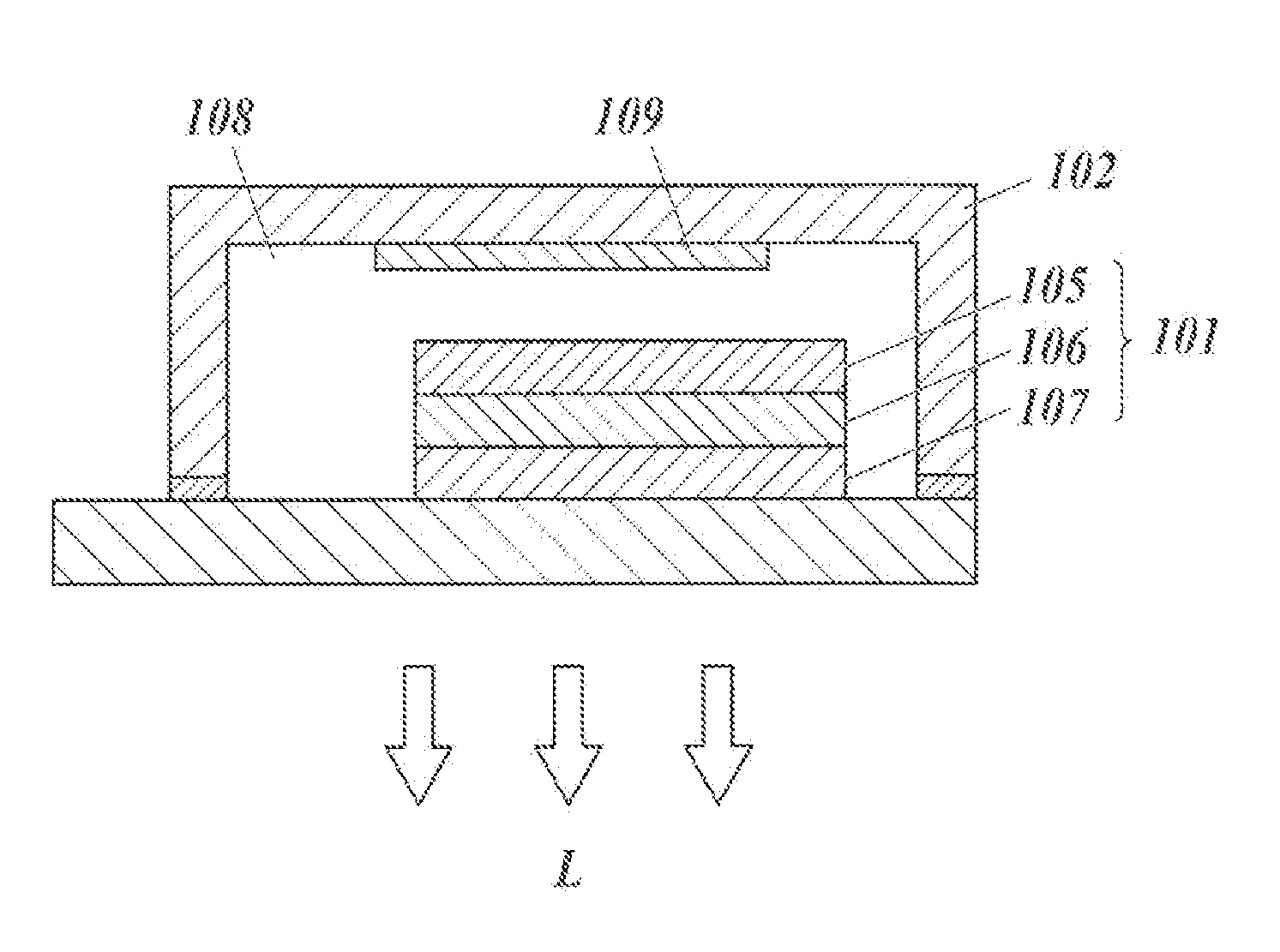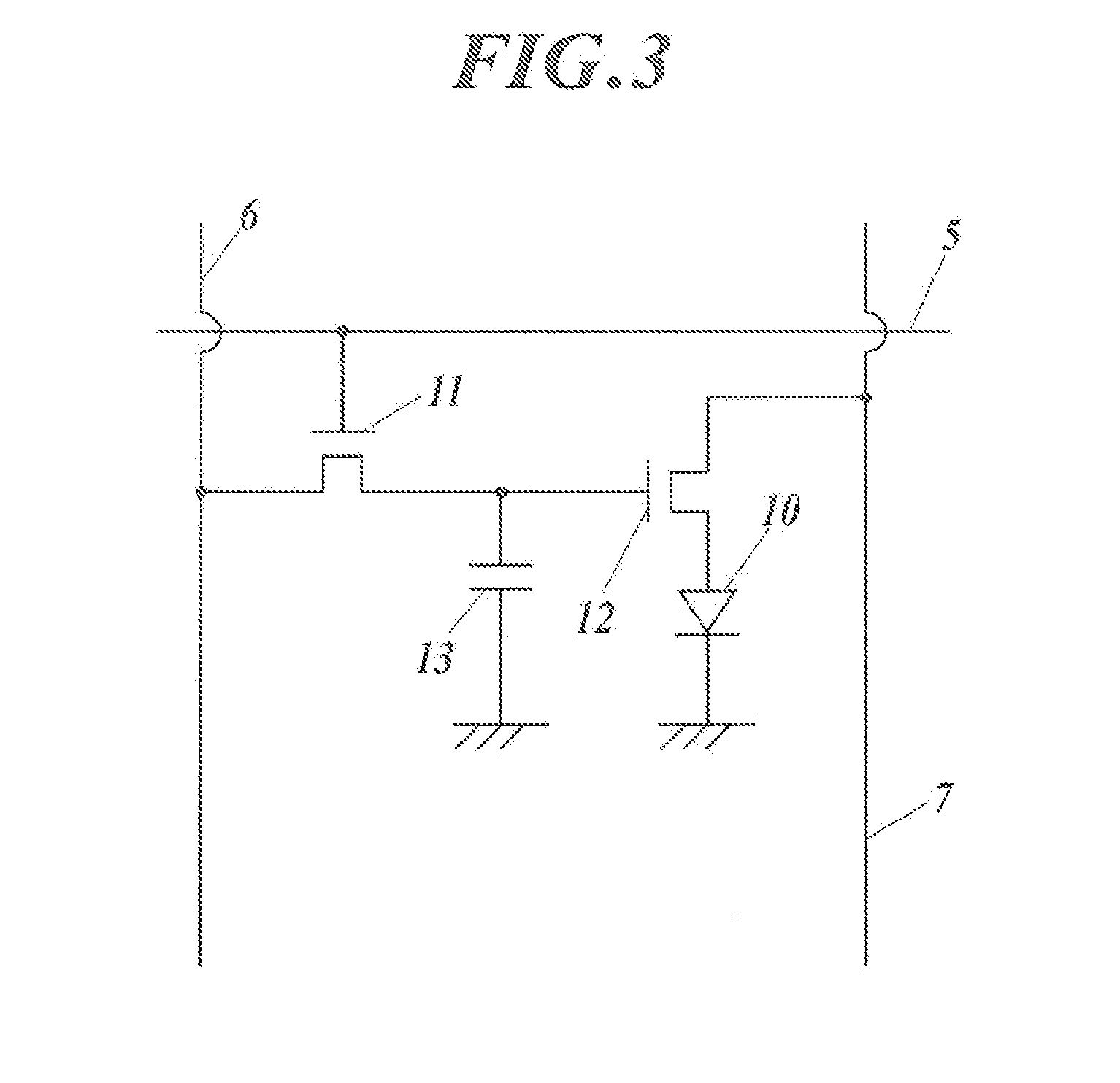Organic electroluminescent element
a technology of electroluminescent elements and organic el elements, which is applied in the field of organic electroluminescent elements, can solve the problems of insufficient light emission efficiency, lifetime and stable chromaticity, and the demand for emission color stability is particularly severe, and achieves high light emission efficiency, long emission lifetime, and high light emission efficiency.
- Summary
- Abstract
- Description
- Claims
- Application Information
AI Technical Summary
Benefits of technology
Problems solved by technology
Method used
Image
Examples
example 1
Preparation of Organic EL Element 1-1
[0300]A substrate (NA45 available from NH TECHNOGLASS CORPORATION), which was a glass substrate of 100 mm by 100 mm by 1.1 mm thick provided with an anode of a 100 nm thick ITO (indium tin oxide) film thereon, was subjected to patterning. The resulting transparent supporting substrate provided with the transparent ITO electrode was cleaned in isopropyl alcohol with an ultrasonic cleaner, dried with nitrogen gas, and then exposed to UV / ozone for five minutes.
[0301]The transparent supporting substrate was fixed on the substrate holder in a commercially available vacuum deposition apparatus. 200 mg of HT-30 was placed in a resistively heated molybdenum boat, 200 mg of HT-2 was placed in another resistively heated molybdenum boat, compound 2-45 was placed in another resistively heated molybdenum boat, 200 mg of HS-1 was placed in another resistively heated molybdenum boat, 200 mg of DP-1 was placed in another resistively heated molybdenum boat, 200 m...
example 2
Preparation of Organic EL Element 2-1
[0319]A substrate (NA45 available from NH TECHNOGLASS CORPORATION), which was a glass substrate of 100 mm by 100 mm by 1.1 mm thick provided with an anode of a 100 nm thick ITO (indium tin oxide) film thereon, was subjected to patterning. The resulting transparent supporting substrate provided with the transparent ITO electrode was cleaned in isopropyl alcohol with an ultrasonic cleaner, dried with nitrogen gas, and then exposed to UV / ozone for five minutes.
[0320]The transparent supporting substrate was fixed on the substrate holder in a commercially available vacuum deposition apparatus. 200 mg of HT-30 was placed in a resistively heated molybdenum boat, 200 mg of HT-2 was placed in another resistively heated molybdenum boat, compound 2-45 was placed in another resistively heated molybdenum boat, 200 mg of HS-1 was placed in another resistively heated molybdenum boat, 200 mg of DP-1 was placed in another resistively heated molybdenum boat, 200 m...
example 3
Preparation of Organic EL Element 3-1
[0330]A substrate (NA45 available from NH TECHNOGLASS CORPORATION), which was a glass substrate of 100 mm by 100 mm by 1.1 mm thick provided with an anode formed of a 100 nm thick ITO (indium tin oxide) film thereon, was subjected to patterning. The resulting transparent supporting substrate provided with the transparent ITO electrode was cleaned in isopropyl alcohol with an ultrasonic cleaner, dried with nitrogen gas, and then subjected to UV / ozone cleaning for five minutes.
[0331]The transparent supporting substrate was fixed on the substrate holder in a commercially available vacuum deposition apparatus. 200 mg of HT-30 was placed in a resistively heated molybdenum boat, 200 mg of HT-2 was placed in another resistively heated molybdenum boat, 200 mg of compound 2-45 was placed in another resistively heated molybdenum boat, 200 mg of HS-1 was placed in another resistively heated molybdenum boat, 200 mg of DP-1 was placed in another resistively h...
PUM
| Property | Measurement | Unit |
|---|---|---|
| atomic number | aaaaa | aaaaa |
| thickness | aaaaa | aaaaa |
| thickness | aaaaa | aaaaa |
Abstract
Description
Claims
Application Information
 Login to View More
Login to View More - R&D
- Intellectual Property
- Life Sciences
- Materials
- Tech Scout
- Unparalleled Data Quality
- Higher Quality Content
- 60% Fewer Hallucinations
Browse by: Latest US Patents, China's latest patents, Technical Efficacy Thesaurus, Application Domain, Technology Topic, Popular Technical Reports.
© 2025 PatSnap. All rights reserved.Legal|Privacy policy|Modern Slavery Act Transparency Statement|Sitemap|About US| Contact US: help@patsnap.com



